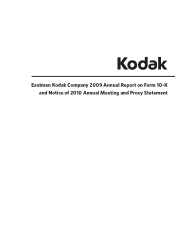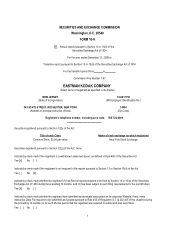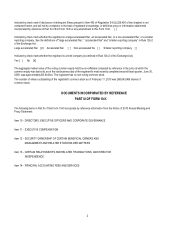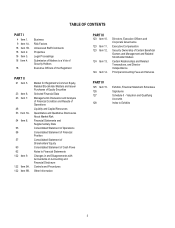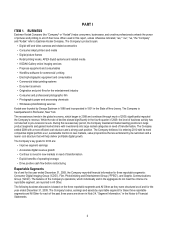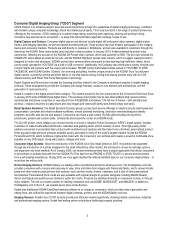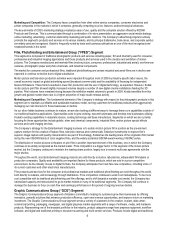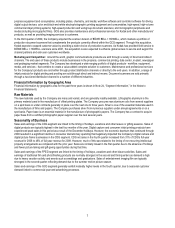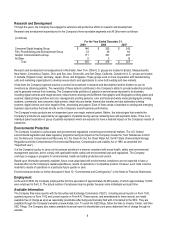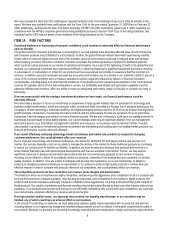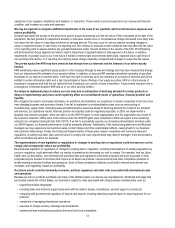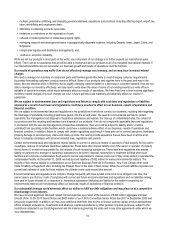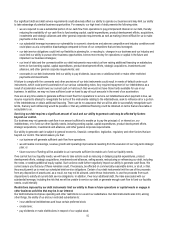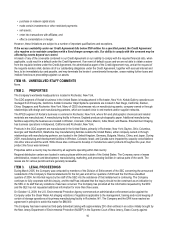Kodak 2009 Annual Report Download - page 11
Download and view the complete annual report
Please find page 11 of the 2009 Kodak annual report below. You can navigate through the pages in the report by either clicking on the pages listed below, or by using the keyword search tool below to find specific information within the annual report. 9
We have included the CEO and CFO certifications required by Section 302 of the Sarbanes-Oxley Act of 2002 as exhibits to this
report. We have also included these certifications with the Form 10-K for the year ended December 31, 2008 filed on February 27,
2009. Additionally, we filed with the New York Stock Exchange (“NYSE”) the CEO certification, dated June 5, 2009, regarding our
compliance with the NYSE's corporate governance listing standards pursuant to Section 303A.12(a) of the listing standards, and
indicated that the CEO was not aware of any violations of the listing standards by the Company.
ITEM 1A. RISK FACTORS
Continued weakness or worsening of economic conditions could continue to adversely affect our financial performance
and our liquidity.
The global economic recession and declines in consumption in our end markets have adversely affected sales of both commercial
and consumer products and profitability for such products. Further, the global financial markets have been experiencing volatility.
Slower sales of consumer digital products due to the uncertain economic environment could lead to reduced sales and earnings
while inventory increases. Economic conditions could also accelerate the continuing decline in demand for traditional products,
which could also place pressure on our results of operations and liquidity. As a result of the tightening of credit in the global financial
markets, our commercial customers have experienced difficulty in obtaining financing for significant equipment purchases, resulting
in a decrease in, or cancellation of, orders for our products and services and we can provide no assurance that this trend will not
continue. In addition, accounts receivable and past due accounts could increase due to a decline in our customers’ ability to pay as a
result of the economic downturn and our treasury operations could be negatively impacted by failures of financial instrument
counterparties, including banks and other financial institutions. If the global economic weakness and tightness in the credit markets
continue for a greater period of time than anticipated or worsen, our profitability and related cash generation capability could be
adversely affected and, therefore, affect our ability to meet our anticipated cash needs, impair our liquidity or increase our costs of
borrowing.
If we are unsuccessful with the strategic investment decisions we have made, our financial performance could be
adversely affected.
We have made a decision to focus our investments on businesses in large growth markets that are positioned for technology and
business model transformation, which are consumer inkjet, commercial inkjet (including our Prosper line of products based upon the
Company’s Stream technology), enterprise workflow, and digital packaging printing solutions, all of which we believe have significant
growth potential. Introduction of successful innovative products and the achievement of scale are necessary for us to grow these
businesses, improve margins and achieve our future financial success. We are also continuing to build upon our leading positions in
businesses that participate in large stable markets. Our current strategic plans require significant attention from our management
team and if events occur that distract management’s attention and resources, our business could be harmed. Further, if we are
unsuccessful in growing our investment businesses as planned and maintaining and building upon our leading market positions, our
financial performance could be adversely affected.
If we cannot effectively anticipate technology trends and develop and market new products to respond to changing
customer preferences, this could adversely affect our revenues.
Due to changes in technology and customer preferences, the market for traditional film and paper products and services is in
decline. Our success depends in part on our ability to manage the decline of the market for these traditional products by continuing
to reduce our cost structure to maintain profitability. In addition, we must develop and introduce new products and services in a
timely manner that keep pace with technological developments and that are accepted in the market. Further, we may expend
significant resources to develop and introduce new products that are not commercially accepted for any number of reasons,
including, but not limited to, failure to successfully market our products, competition from existing and new competitors or product
quality concerns. In addition, if we are unable to anticipate and develop improvements to our current technology, to adapt our
products to changing customer preferences or requirements or to continue to produce high quality products in a timely and cost
effective manner in order to compete with products offered by our competitors, this could adversely affect our revenues.
The competitive pressures we face could harm our revenue, gross margins and market share.
The markets in which we do business are highly competitive, and we encounter aggressive price competition for all our products and
services from numerous companies globally. Over the past several years, price competition in the market for digital products, film
products and services has been particularly intense as competitors have aggressively cut prices and lowered their profit margins for
these products. Our results of operations and financial condition may be adversely affected by these and other industry wide pricing
pressures. If our products and services and pricing are not sufficiently competitive with current and future competitors, we could also
lose market share, adversely affecting our revenue and gross margins.
If we have product quality issues, our expenses may increase, our liquidity may decrease, or our reputation may be
harmed, any of which could have an adverse effect on our business.
In the course of conducting our business, we must adequately address quality issues associated with our products and services,
including defects in our engineering, design and manufacturing processes, as well as defects in third-party components included in
our products. Because our products are becoming increasingly sophisticated and complicated to design and build as rapid advances

